The 10 Busiest Airports In The United States

There are several ways of ranking airports, including by surface area and passenger traffic. Passenger traffic is the number of passengers who pass through an airport within a given time frame, usually one year. These passengers can either be international (from outside the country) or domestic (within the country) passengers. In 2019, airports in the United States served about 1.1 billion passengers.
The number of passengers varied among airports, with some airports serving tens of millions of passengers. The US is home to four of the world’s ten busiest airports. Interestingly, some of the busiest airports in the country are not necessarily the biggest by surface area. Here are the US busiest airports by passenger traffic.
- Hartsfield–Jackson Atlanta International Airport (ATL) - 103.9 M
- Los Angeles International Airport (LAX) - 84.5 M
- O’Hare International Airport (ORD) - 79.8
- Dallas/Fort Worth International Airport (DFW) - 75 M
- Denver International Airport (DEN) - 61 M
- John F. Kennedy International Airport (JFK) - 61 M
- San Francisco International Airport (SFO) - 56 M
- McCarran International Airport (LAS) - 51 M
- Seattle-Tacoma International Airport (SEA) - 50 M
- Charlotte Douglas International Airport (CLT) - 46 M
1. Hartsfield–Jackson Atlanta International Airport (ATL) - 103.9 M
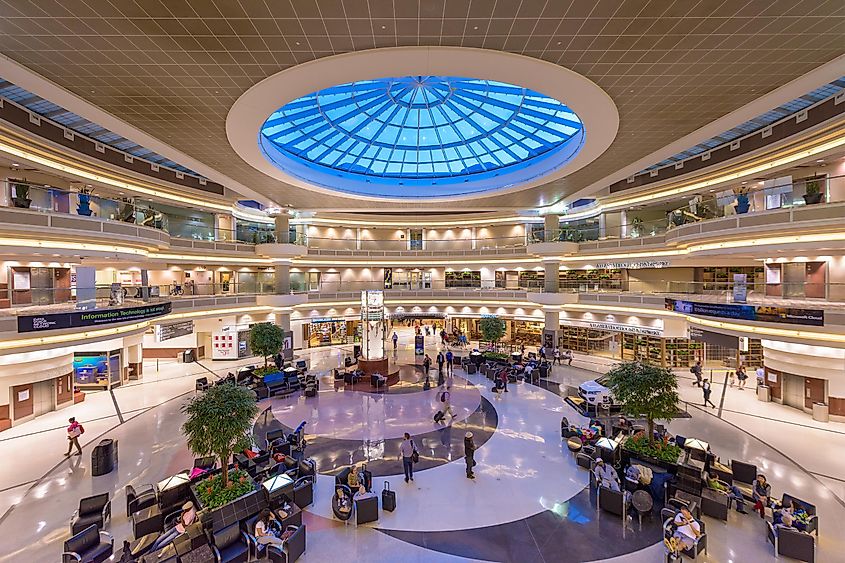
Atlanta Airport is the US’ busiest airport by passenger traffic. It has been the world’s busiest airport since 1998. Approximately 104 million people traveled through it in 2019, 20 million passengers more than the second busiest airport. ATL is located 11 kilometers away from Atlanta and named after Maynard Jackson and William Hartfield, Georgia’s two former mayors. It occupies 19.02 square kilometers and is Delta Air Lines’ hub and also its technical operations center. It is an international gateway to the US and has the 7th highest international passengers.
2. Los Angeles International Airport (LAX) - 84.5 M

About 84.5 million passengers passed through Los Angeles International Airport in 2019, making it the US second busiest airport by passenger traffic. Approximately 51.2% of the passengers who used the airport were outbound passengers. LAX serves Greater Los Angeles and is located about 30 kilometers from Los Angeles, in the Westchester neighborhood. It is an international gateway to the US and provides connections to international travelers. It occupies approximately 14 square kilometers and has nine terminals, four runways, and 132 gates. Opened in 1930, the airport was known as Mines Field.
3. O’Hare International Airport (ORD) - 79.8

O’Hare is the US 7th-largest airport by area, covering 30.9 square kilometers. However, it is the third busiest airport by passenger traffic, recording 79.8 million passengers. It was the country’s busiest airport by passenger numbers between 1963 and 1998. The airport has direct nonstop flights to over 220 destinations on all six inhabited continents. In 2019, O’Hare served close to 920,000 aircraft or an average of 2,520 aircraft daily. It is a major hub for some of the largest airlines, such as American Airlines and United Airlines.
4. Dallas/Fort Worth International Airport (DFW) - 75 M
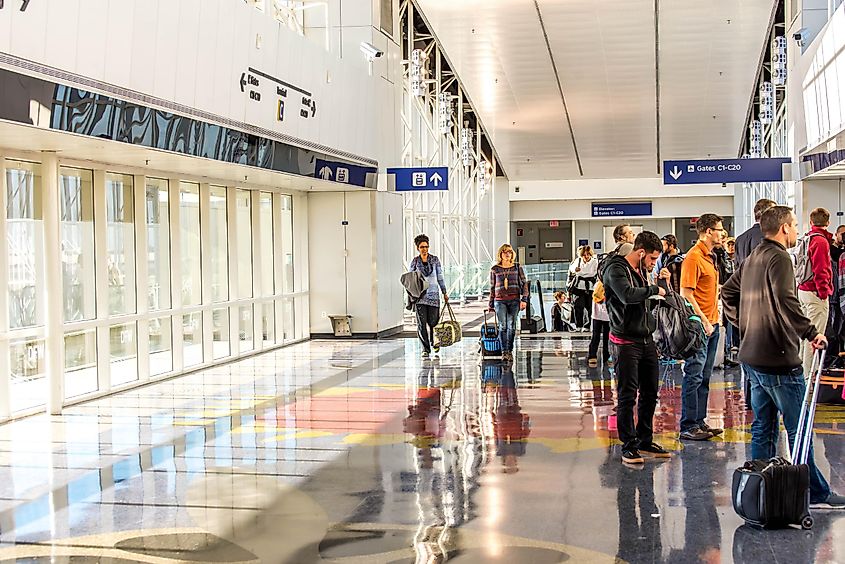
DFW Airport is the world’s 10th busiest airport by passenger numbers and the US's 4th busiest airport. It is located between Dallas and Fort Worth, covering 69.63 square kilometers. In 2019, the airport served 75 million passengers, the most in its 45 years of existence. It has service to over 250 destinations, the majority being domestic destinations within the country. About 35.9 million passengers who used DFW Airport in 2019 were outbound, of which 31.2 million departed to domestic destinations. The airport has its fire protection unit, Zip Code, police, and emergency services.
5. Denver International Airport (DEN) - 61 M
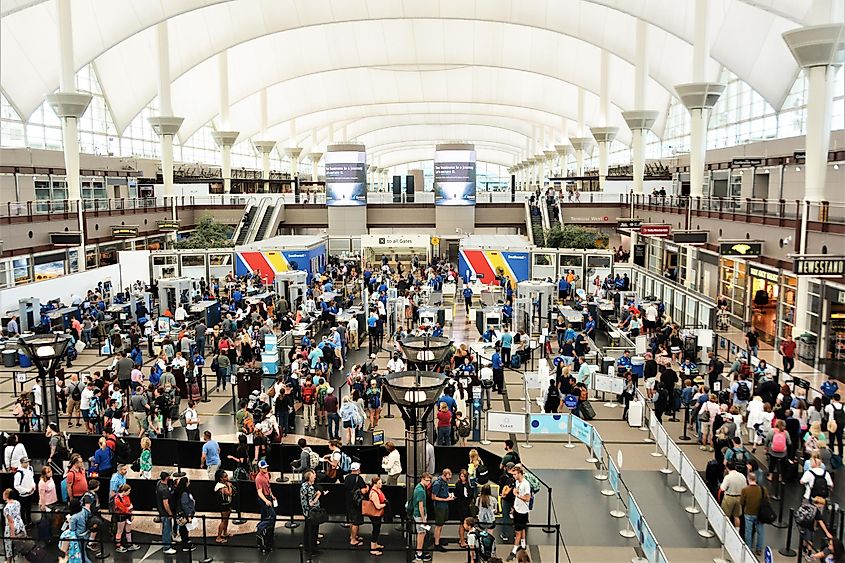
Denver International Airport is the US’ largest and world’s third-largest airport after King Fahd International Airport and Beijing Daxing International Airport. It occupies 135.7 square kilometers and has the 7th longest runway in the world. However, DIA is the US’ 5th largest airport by passenger numbers, with 61 million passengers in 2019. 33.9 million passengers who used the airport were outbound, of which 96% were domestic outbound passengers. The airport was opened in 1995 and currently has service in 215 destinations.
5. John F. Kennedy International Airport (JFK) - 61 M
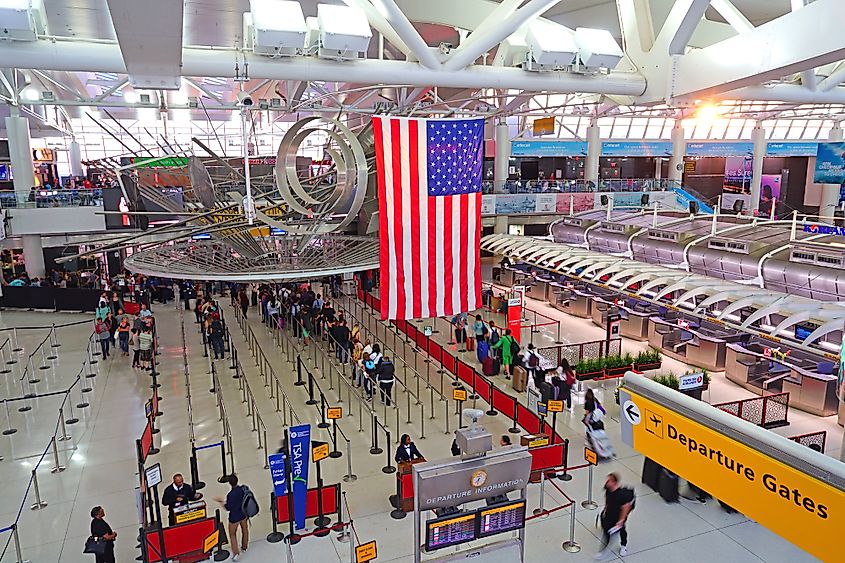
JFK Airport is the world’s 20th busiest airport and the US’ 6th busiest airport, with 61 million passengers. Formerly known as New York International Airport, JFK is North America’s busiest international gateway. The airport is located in Queens, approximately 26 kilometers away from Midtown Manhattan. Opened in 1948, JFK Airport serves over 90 airlines, with direct flight to the six inhabited continents. The airport is a hub for two legacy carriers; Delta Air Lines and American Airlines, and JetBlue’s operating base. It has six passenger terminals with 131 gates.
7. San Francisco International Airport (SFO) - 56 M

San Francisco is California’s second busiest airport by passenger traffic after Los Angeles International Airport. However, it the busiest airport in San Francisco Bay Area, serving 56 million passengers. About 49% of the passengers who passed through SFO were outbound. The airport is located 21 kilometers south of San Francisco. It is an important international gateway to Asia and Europe and service flights to every corner of North America. SFO is Alaska Airlines’ hub and United Airlines’ 5th largest hub. It has four runways that are arranged in such a way that they form a cross sign.
8. McCarran International Airport (LAS) - 51 M
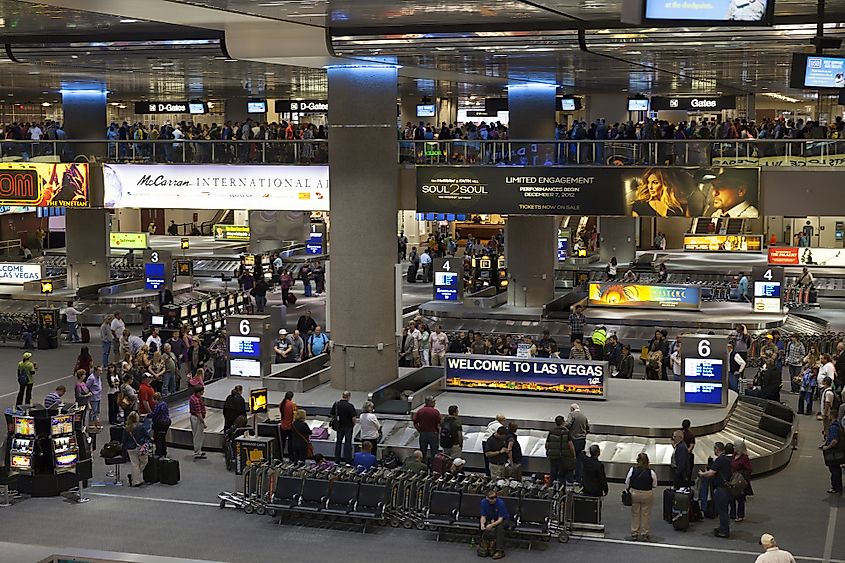
Located approximately 8 kilometers south of Las Vegas, Harry Reid International Airport occupies 11.3 square kilometers. It was constructed in 1942 and opened to flights in 1948. LAS is currently the 8th busiest airport in the US, serving 51 million passengers in 2019. It is the US’ busiest airport that is not a hub to any airline. However, it serves as a base for several airlines, including Frontier Airlines, Allegiant Air, and Southwest Airlines. Initially, the runways were made of asphalt, but are now made of concrete.
9. Seattle-Tacoma International Airport (SEA) - 50 M
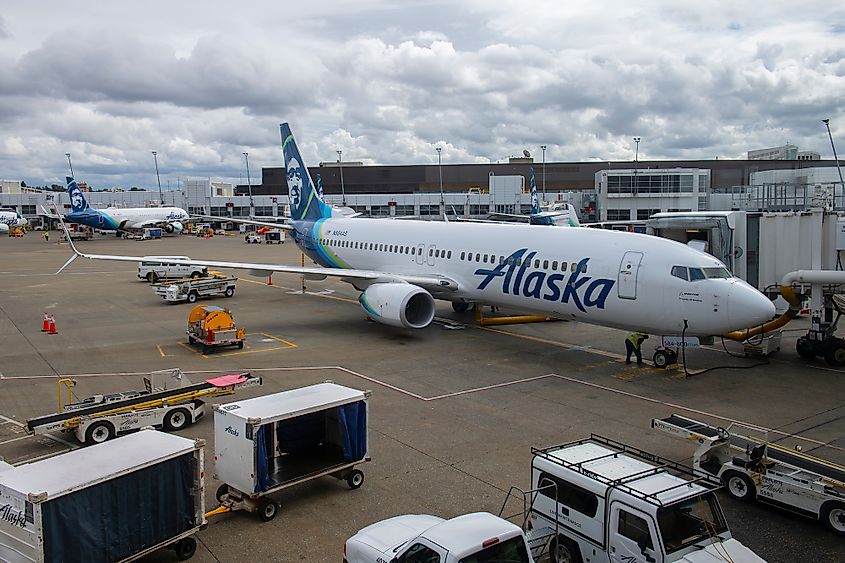
Sea-Tac Airport is the main commercial airport for Seattle, Washington. It is located in SeaTac City, approximately 23 kilometers from Seattle's central business district and 29 kilometers away from Tacoma. SEA is Cascadia’s largest airport, located between Portland (US) and Vancouver (Canada). It serves flights to most cities in Europe, Oceania, Asia, Middle East, and North America. The airport is Alaska Airlines’ primary hub, as well as Delta Airlines’ international gateway to Asia. About 50 million passengers passed through SEA in 2019, making it the US’ 9th busiest airport. The airport has a surface area of 10 square kilometers.
10. Charlotte Douglas International Airport (CLT) - 46 M

CLT Airport was opened in 1935 as Charlotte Municipal Airport. 19 years later, it was renamed after Ben Elbert Douglas, Charlotte’s mayor, when the airport was first constructed. The present name was given to the airport in 1982. CLT is located about 10 kilometers from Charlotte and is an airport for military and commercial use. With 46 million passengers passing through the airport, it is the US’ 10th busiest airport. It is American Airlines’ hub, which operates 700 daily flights to over 149 destinations. The airport has one passenger terminal, four runways, and 115 gates.

Comments
Post a Comment